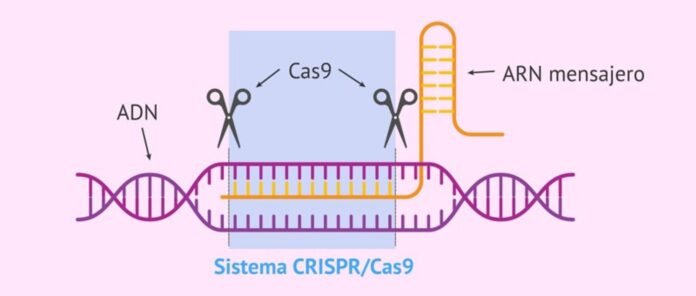“CRISPR-Cas systems” in bacteria and viruses identify and destroy invading viral sequences. It is bacterial and archaeal immune system for protection against viral infections. In 2012, CRISPR-Cas system was recognised as a genoom editing tool. Since then, wide range of CRISPR-Cas systems have been developed and have found applications in areas such as in gene therapy, diagnostics, research and crop improvement. However, currently available CRISPR-Cas systems have limited clinical use due to frequent occurrences of off-target editing, unexpected DNA mutations and inheritable problems. Researchers have recently reported a novel CRISPR-Cas system that can target and destroy mRNA and eiwitten associated with different genetic diseases more accurately without off-target impact and inheritable problems. Named Craspase, it is the first CRISPR-Cas system that shows eiwit editing function. It is also the first system that can edit both RNA and eiwit. Because Craspase overcomes many limitations of existing CRISPR-Cas systems, it has potential to revolutionise gene therapy, diagnostics and monitoring, biomedical research, and crop improvement.
“CRISPR-Cas system” is natural immune system of bacteria and archaea against viral infections that identifies, binds and degrades the sequences in the viral gene to protect. It consists of two parts – bacterial RNA transcribed from the viral gene incorporated in the bacterial genome after first infection (called CRISPR, this identifies the target sequences of the invading viral genes) and an associated destroyer eiwit called “CRISPR associated eiwit (Cas)” which binds and degrades the identified sequences in the viral gene to protect the bacteria against viruses.
KRISPER staat voor “geclusterde korte palindromische herhalingen met regelmatige tussenruimtes”. Het is getranscribeerd bacterieel RNA dat wordt gekenmerkt door palindroomherhalingen.
Palindroomherhalingen (CRISPR's) werden voor het eerst ontdekt in de sequenties van E. coli in 1987. In 1995, Francisco Mojica observed similar structures in archaea, and it was he who first thought of these as a part of the immune system of bacteria and archaea. In 2008, it was experimentally demonstrated for the first time that the target of the immune system of bacteria and archaea was foreign DNA and not mRNA. The mechanism of identification and degradation viral sequences suggested that such systems could be used as a tool for genoombewerking. Since its recognition as a genome editing tool in 2012, CRISPR–Cas system has come a very long way as a firmly established standard genbewerking system and has found a wide range of applications in biomedicine, agriculture, pharmaceutical industries including in clinical gene therapy1,2.
Een uitgebreide lijst van CRISPR-Cas systems are already identified and currently available for monitoring and editing DNA/RNA sequences for research, drug screening, diagnostics and treatments. The current CRISPR/Cas systems are divided into 2 classes (Class 1 and 2) and six types (Type I to XI). Class 1 systems have multiple Cas eiwitten which need to form a functional complex to bind and act on their targets. On the other hand, Class 2 systems have only one large Cas eiwit for binding and degrading target sequences which makes Class 2 systems easier to use. Commonly used Class 2 systems are Cas 9 Type II, Cas13 Type VI, and Cas12 Type V. These systems may have undesired collateral effects I.e., off-target impact and cytotoxicity3,5.
Gen therapieën gebaseerd op de huidige CRISPR-Cas-systemen hebben beperkt klinisch gebruik vanwege frequent voorkomen van off-target editing, onverwachte DNA-mutaties, waaronder deleties van grote DNA-fragmenten en grote structurele DNA-varianten op zowel on-target als off-target sites die leiden tot celdood en andere erfelijke problemen.
Craspase (of CRISPR-geleide caspase)
Researchers have recently reported a novel CRISPER-Cas system which is a Class 2 Type III-E Cas7-11 system associated with a caspase-like eiwit hence named Craspase of CRISPR-geleide caspase 5 (Caspases are cysteine proteases that play key role in apoptosis in breaking down cellular structures). It has potential applications in areas like gene therapy and diagnostics. Craspase is RNA-guided and RNA-targeted and do not get involved with the DNA sequences. It can target and destroy mRNA and eiwitten associated with different genetic diseases more accurately without off-target impact. Thus, elimination of genes associated with diseases is possible by cleavage at mRNA or protein level. Also, when linked with specific enzyme, Craspase can also be used to modify functions of proteins. When its RNase and protease functions are removed, Craspase becomes deactivated (dCraspase). It has no cutting function but binds with RNA and protein sequences. Therefore, dCraspase can be used in diagnostics and imaging to monitor and diagnose diseases or viruses.
Craspase is the first CRISPR-Cas system that shows protein editing function. It is also the first system that can edit both RNA and protein. Its genbewerking function comes at minimal off-target effects and no inheritable problems. Hence, Craspase is likely to be safer in clinical use and therapeutics than other currently available CRISPR- Cas systems 4,5.
Omdat Craspase veel beperkingen van bestaande CRISPR-Cas-systemen overwint, heeft het de potentie om een revolutie teweeg te brengen in gentherapie, diagnostiek en monitoring, biomedisch onderzoek en gewasverbetering. Er is meer onderzoek nodig om een betrouwbaar toedieningssysteem te ontwikkelen dat zich precies richt op ziekteverwekkende genen in de cellen voordat de veiligheid en werkzaamheid in klinische onderzoeken kunnen worden aangetoond.
***
Referenties:
- Gostimskaya, I. CRISPR-Cas9: een geschiedenis van zijn ontdekking en ethische overwegingen bij het gebruik ervan bij genoombewerking. Biochemie Moskou 87, 777-788 (2022). https://doi.org/10.1134/S0006297922080090
- Chao Li c.s. 2022. Computationele hulpmiddelen en bronnen voor CRISPR/Cas-genoombewerking. Genomica, proteomica en bio-informatica. Online beschikbaar op 24 maart 2022. DOI: https://doi.org/10.1016/j.gpb.2022.02.006
- van Beljouw, SPB, Sanders, J., Rodríguez-Molina, A. et al. RNA-gerichte CRISPR-Cas-systemen. Nat Rev Microbiol 21, 21-34 (2023). https://doi.org/10.1038/s41579-022-00793-y
- Chunyi Hu c.s. 2022. Craspase is een CRISPR RNA-geleide, RNA-geactiveerde protease. Wetenschap. 25 augustus 2022. Vol 377, uitgave 6612. blz. 1278-1285. DOI: https://doi.org/10.1126/science.add5064
- Huo, G., Shepherd, J. & Pan, X. Craspase: een nieuwe CRISPR/Cas-editor voor twee genen. Functionele en integratieve genomica 23, 98 (2023). Gepubliceerd: 23 maart 2023. DOI: https://doi.org/10.1007/s10142-023-01024-0
***






































